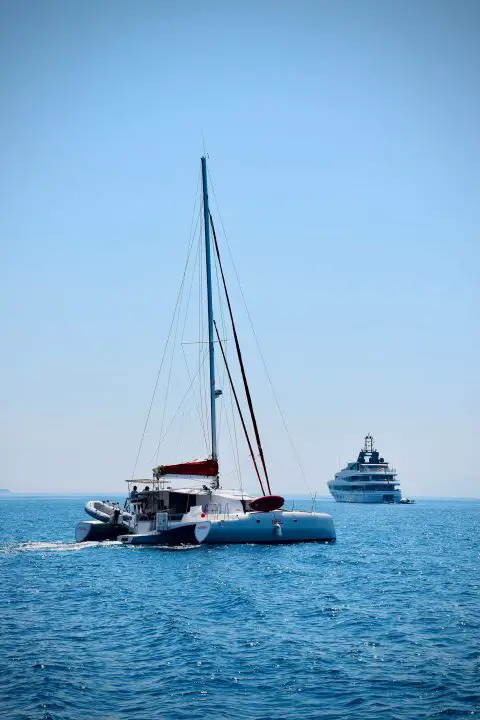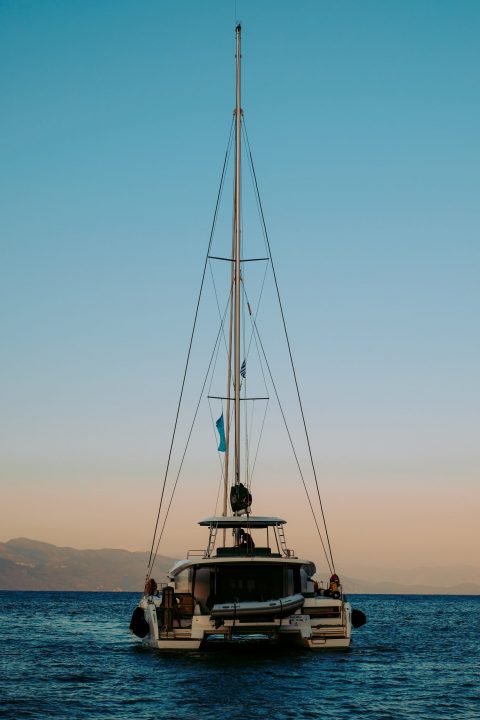For years, catamarans have dominated the multihull segment. Cruisers love to live aboard and sail the world on sailing catamarans. These two-hull boats are known for their speed, space, and overall attractiveness.
With their sporty three hulls, trimarans have long been regarded as fantastic race boats that will speed past catamarans and monohulls. Trimarans have stability and are comfortable at sea. Today’s modern trimarans, such as the Neel brand trimarans, are now featuring increased living space. As a result, modern trimarans are becoming more attractive and more appealing to cruising and liveaboard sailors.

Table of Contents
- Differences of Trimaran Versus Catamaran
- The Benefits of Three Hulls
- Multihull Safety
- Sailing Comfort
- Choosing Between Catamarans and Trimarans
- FAQs – Catamarans Vs Trimarans
Differences of Trimaran Versus Catamaran
The main difference between a monohull, a catamaran, and a trimaran is the hull configuration. A monohull has just one hull. A catamaran has two hulls, and a trimaran has three hulls. The catamaran and trimaran are known as multihulls because they each have more than one hull.
A catamaran has two equally sized hulls, whereas a trimaran has one main hull with two outriggers. The two outriggers are smaller and are mirror images of each other.
Living Space
The living space on a catamaran is usually luxurious compared to monohulls and trimarans. First, a large cockpit has plenty of room for guests. Second, the bridge deck, which connects the two hulls, is flat, large, and usually hosts a large living area. Third, the living area has large windows which allow excellent visibility, natural light, and ventilation. Finally, the two hulls usually house sleeping areas, bathrooms, and sometimes galleys.
On a trimaran, the living space is usually smaller than on a catamaran. The main hull is usually home to the main living quarters. Like a monohull, this space may be darker with fewer portlights. Often, the living space on a trimaran is even smaller than a comparably sized monohull. On most smaller trimarans, the outrigger hulls are kept empty or used as storage.
New, large, modern trimarans like the Neel 47 offer luxury living similar to a catamaran. On a Neel trimaran, you’ll find a large, spacious cockpit and saloon area. This area provides outdoor seating in the cockpit and an indoor lounge that rivals the comfort of home. The outriggers have space for private bunks and bathroom facilities.
The Benefits of Three Hulls
While you may give up some living space on a trimaran, there are some benefits. Trimarans are even faster than catamarans. Trimarans only have one main hull fully in the water, and the two outriggers produce less drag. As a result, trimarans have stability and are great fun to sail.
Catamaran vs Trimaran Performance
A trimaran usually has the forestay attached to the main hull. This provides a strong, stable, safe rigging platform.
A catamaran’s forestay is attached to the forward center of the boat on a crossbeam, the shrouds are attached to each hull, and there often isn’t a backstay. This catamaran rigging configuration allows for additional fatigue as the rig is being pulled in various directions.
The trimaran rigging configuration is similar to a traditional monohull. The standing rigging is connected to the center hull, thus providing increased stability and less fatigue. This configuration allows for a rigid forestay and provides good upwind performance.
When comparing trimaran and catamaran upwind performance, the trimaran usually wins. Because of the trimaran’s larger central platform and two outriggers, the trimaran pitches less when heading upwind, also known as beating. Catamarans also experience more drift while beating into the wind. So overall, trimarans experience less leeway and have better upwind performance.
Pros and Cons of Cruising on a Monohull Boat
Monohull boats have been around forever. As such, you can easily buy an older monohull to learn to sail on. Monohulls are inexpensive to purchase, maintain, and operate. It’s more straightforward to find marina docks and haul-out locations. When it comes to maintenance, like bottom cleaning, washing, waxing, and fiberglass work, nothing beats having a single hull!
But monohulls have much less living space than a cruising catamaran. The living space is often dark and can be called “cave-like,” as monohulls tend to have small ports.

Monohulls heel over, which is attractive to some and a deterrent to others. Some sailors feel more seasick on a monohull as it heels. On the other hand, some feel less seasick as the motion is constant, unlike a catamaran’s sometimes jerky motion underway.
Most monohulls have deeper keels than catamarans and trimarans. A shallower draft allows sailors to access shallower water. Boats with shallower keels can sneak into desirable anchorages that deeper draft boats cannot access.
Pros and Cons of Cruising Catamarans
Cruising catamarans have large amounts of living space and are known to be luxurious. They don’t heel over as monohulls do. Catamarans provide a stable platform for enjoying life on the water. And some sailors feel less seasick on a catamaran because of the lack of heeling motion.
Catamarans are popular with charter companies, cruisers, and sailors planning to sail around the world. Catamarans have shallow drafts and can sneak into attractive anchorages that deeper draft monohulls can’t access.

Catamarans are wider than monohulls, and it can be harder and more expensive to find marina dockage and haulouts. They don’t fit into standard-size slips and must dock in extra-wide slips or at t-heads. Many maintenance yards have standard-sized lifts that don’t accommodate the width of a catamaran. So overall, catamarans are more expensive to buy, operate, and maintain than monohull boats.
Pros and Cons of Cruising on a Trimaran
Trimarans are known for their speed! If you love to cruise past all the other boats and get to port first, a trimaran might be calling your name. Traditional trimarans have limited living space on board. Most trimarans have even less living space than similarly sized monohulls.
Maneuvering around the trimaran and living aboard can provide challenges for sailors. Like catamarans, their width can make getting dock space and haul-outs more challenging and expensive.

Cruising catamarans are usually between 18 and 25 feet wide. Cruising trimarans are usually between 25 and 30 feet wide. The additional width of a trimaran creates a more stable platform but makes finding dockage even more challenging.
Multihull Safety
Catamarans and trimarans are both considered safe vessels. While a monohull might roll, lose its rig, get holed, and sink to the bottom of the ocean, a multihull vessel will still float. This is because they do not contain lead or iron ballast.
While it is very rare, multihulls can be flipped. For instance, after Category 5 hurricanes, news outlets often share photos of flipped catamarans that were left at marinas.
However, even when a multihull is flipped, it still provides a floating platform. Boaters can wait with their large overturned vessel for help, and rescuers are more likely to spot an overturned vessel than just a small liferaft. In addition, supplies carried on the boat might still be accessible to the crew.
Cruising sailors often consider increased speed to be a safety factor. For instance, on an ocean crossing, faster speeds mean that sailors might be able to arrive before a big storm rather than getting caught in it. In addition, a faster boat might be able to adjust course and avoid the storm if outrunning it is not an option. Because trimarans are faster than both catamarans and monohulls, they can outrun or avoid more storms.
Sailing Comfort
A trimaran features less roll than a catamaran. A trimaran’s weight is centered in its main hull, whereas a catamaran’s weight is distributed across both hulls. As a result, the trimaran rides smoother, whereas a catamaran will be reacting more dramatically and face a bumpier ride.

Choosing Between Catamarans and Trimarans
If you’re thinking about sailing on a multihull, consider the living space, speed, and sea kindliness of each. In the end, it’s a decision made from personal taste and personal preference. Trimarans are fast and fun to sail. Catamarans offer increased deck-level living space. Both are known to be safe and virtually unsinkable. Whichever choice floats your boat, you’ll be thrilled with a fun sail, comfortable ride, access to beautiful secluded anchorages in shallow waters.
Worried about getting caught in severe storm conditions in your boat? Visit our guide!
FAQs – Catamarans Vs Trimarans
Is a trimaran faster than a catamaran?
A trimaran is faster than a catamaran. The centered weight in the main hull provides stability. A rigid forestay provides good upwind performance. The reduction in wetted surface reduces drag. A 40-foot monohull may cruise at 6 knots, a 40 ft catamaran may cruise at 7 knots, and a 40ft trimaran may cruise at 9 knots.
Which is more stable, a catamaran or trimaran?
A trimaran has a larger maximum righting moment. Catamaran sailors must be very mindful of the wind conditions and reef sails early to prevent capsizing. The righting moment on cruising catamarans is 12 degrees, whereas the righting moment on a trimaran is 32 degrees. This means the trimaran is more stable.
In jostling rough seas, the trimaran has a smaller righting moment. As heavy seas jostle the boat, it will respond with a less choppy motion. The catamaran has a larger righting moment and will respond with a choppy ride. In a trimaran, you experience more stability. This, in turn, leads to a better-rested crew and a smoother overall ride.
All of a trimaran’s weight is centered in the main hull. In a catamaran, heavy items such as engines are located in each hull. The weight distribution on a catamaran can lead to a jerkier ride.
Can a trimaran capsize?
All boats can capsize given extreme conditions.
Many charter catamarans flipped when Hurricane Irma’s 215 mph winds hit the British Virgin Islands in 2018. The 100-foot trimaran Banque Populaire IX capsized in a gust of wind in 2018.
Multihulls are usually very stable and only encounter the risk of capsizing in severe conditions. Crews should monitor conditions and reef early to prevent overpowering the boat.

